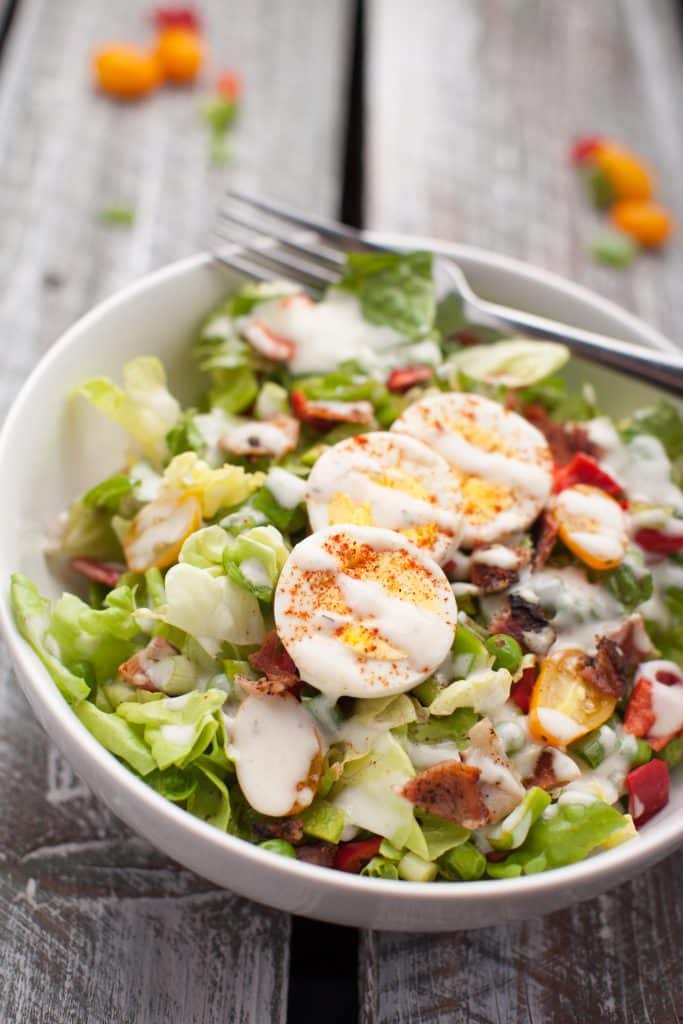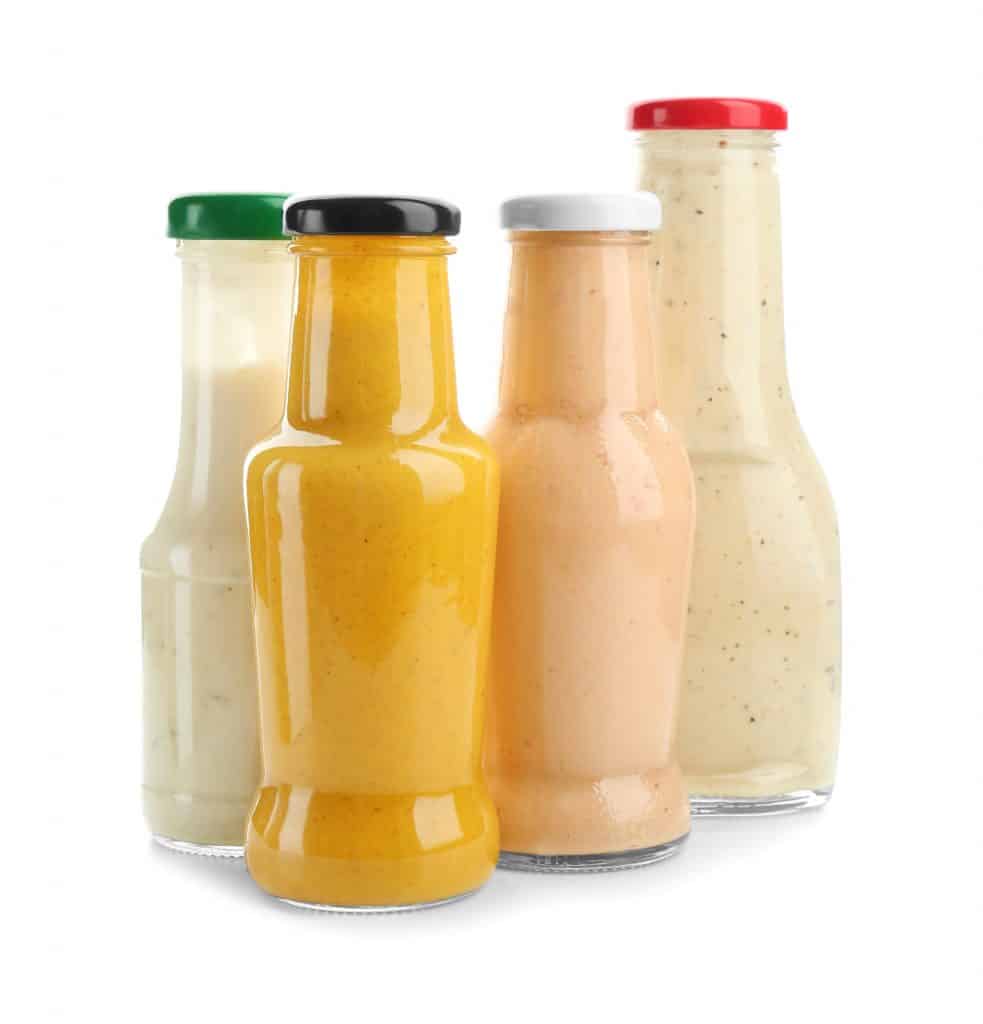Salads were favorites in the great courts of European Monarchs. Royal chefs often combined as many as 35 ingredients in one enormous salad bowl, and included exotic green ingredients such flower petals. England’s King Henry IV’s favorite salad was a tossed mixture of new potatoes (boiled and diced), sardines and herb dressing. Mary, Queen of Scots, preferred boiled celery root diced and tossed with lettuce, creamy mustard dressing, truffles, chervil and hard-cooked egg slices.
History of Salad Dressings
Salad dressings have a long and colorful history, dating back to ancient times.

In the twentieth century
Americans began using basic dressing ingredients (oil, vinegar or lemon juice, and spices) to create an infinite variety of dressings to complement salads.
Prepared dressings were largely unavailable until the turn of the century. Until then, home chefs had to start from scratch. Due to variations in ingredients, partly because of lacking storage conditions and year-round supply sources), results varied significantly. Gradually, restaurants began packaging and selling their consistent dressings product to customers, and the salad dressing industry began.
Many of the major brands of salad dressings available today were on the market as early as the 1920’s.
In 1896, Joe Marzetti opened a restaurant in Columbus, OH and began to serve his customers a variety of dressings developed from old country recipes. He began packaging his dressings to sell to restaurant customers in 1919.
In 1912, Richard Hellmann, a deli owner in New York, began to sell his blue ribbon mayonnaise in wooden containers. One year later, in response to a very strong consumer demand, Mr. Hellmann began to market the mayonnaise in glass jars.
In 1925, the Kraft Cheese Company entered the salad products business with the purchase of several regional mayonnaise manufacturers and the Milani Company (which led to Kraft’s initial entry into the pourable dressing business with French Dressing as its first flavor).

What’s In a Name?
Coleslaw: Dutch word for cabbage is “kool” which led to the English word for a cabbage-based salad.
Mayonnaise: Many authorities believe the first batch of this mixture of egg yolks, oil and seasonings was whipped up to celebrate the 1756 French capture of Mahon (accent on the “o”), a city on the Spanish Isle of Minorca, by forces under Louis-Francois-Armad de Vignerot du Plessis, duc de Richelieu. Besides enjoying a reputation as a skillful military leader, the Duke was also widely known as a bon vivant with the odd habit of inviting his guests to dine in the nude. The Duke, or more likely, his personal chef, is credited with inventing this edible monument to that strategic success.
Horseradish: (Prepared) Horseradish has nothing to do with horses and it is not a radish (it’s a member of the mustard family). The name may have come from an English adaptation of its German name. In early times the plant grew wild in European coastal areas; the Germans called it meerrettich, or sea radish. The German word meer sounds like mare in English. Perhaps mareradish eventually became horseradish. The word horseradish first appeared in print in 1597 in John Gerarde’s English herbal on medicinal plants.
Caesar Salad: Honors restaurateur Caesar Cardini, who invented it in Tijuana, Mexico in 1924. Cardini’s original recipe included romaine, garlic, croutons, Parmesan cheese, boiled eggs, olive oil and Worcestershire sauce. He was said to be staunchly against the inclusion of anchovies in this mixture, contending that the Worcestershire sauce was what actually provided that faint fishy flavor.
Russian Dressing: Got its name because the earliest versions of the mixture of mayonnaise, pimientos, chives, ketchup, and spices included a distinctly Russian ingredient: caviar.
Salad: Comes from the Latin herba salta or “salted herbs”, so called because such greens were usually seasoned with dressings containing lots of salt.
Thousand Island: Made from bits of green olives, peppers, pickles, onions, hard-boiled eggs and other finely chopped ingredients, this chunky dressing is said to commemorate the Thousand Islands in the Saint Lawrence River.
Cobb Salad: Was the invention of yet another restaurateur, Bob Cobb, who in 1926 at his Los Angeles restaurant, now known as The Brown Derby, found a way to use up leftovers. The original recipe for Cobb salad: avocado, celery, tomato, chives, watercress, hard-boiled eggs, chicken, bacon and Roquefort cheese.
Green Goddess Dressing: A mixture of mayonnaise, anchovies, tarragon vinegar, parsley, scallions, garlic, and other spices was created at San Francisco’s Palace Hotel in the 1920’s for actor George Arliss, who stayed there while performing in The Green Goddess, a play that later became one of the earliest “talkie” movies.
Salad Days: Refers to a time of youthful inexperience, a term coined by Shakespeare, whose Cleopatra characterizes her long-ago romance with Julius Caesar as one occurring in “my salad days, when I was green in judgment, cold in blood.”
(Source: Ladyfingers & Nun’s Tummies — A Lighthearted Look at How Foods Got Their Names by Martha Barnette)